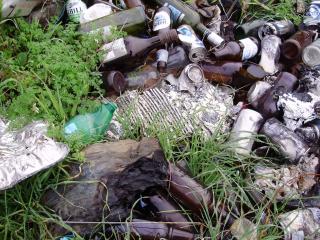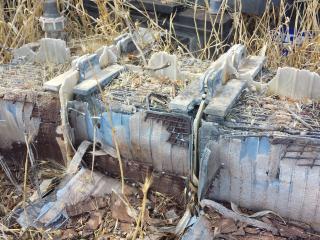| The WA Livestock Disease Outlook provides information about recent livestock disease cases in Western Australia and diseases likely to occur in the next month. Calling a vet to investigate diseases when they occur provides surveillance evidence to our markets that we are free of reportable and trade-sensitive diseases. |
Recent livestock disease cases in WA
Lead poisoning in cattle on two South West properties
- Two recent cases of lead poisoning in cattle in the South West underline the importance of checking and removing all sources of lead such as burnt or discarded batteries before putting stock onto paddocks.
- In one case, a mob of 12 yearling Murray Grey steers was moved to a new paddock.
- The following week, four steers suddenly became ill and began behaving abnormally. They showed tremors, stupor, confusion and drooling before convulsing and dying suddenly.
- In the second case, four Angus cross cows from a mob of 110 died over a three-week period. One affected animal wandered aimlessly, stopped eating and went blind.
- A vet carried out a post-mortem in both cases and submitted samples to the DPIRD laboratory where lead poisoning was diagnosed. Old batteries left in the paddock are likely to have been the source of the lead in the first case.
- Both properties were quarantined and the remaining animals cannot be moved until laboratory testing has confirmed they are free of lead residues.
- Lead is toxic to livestock. Cattle have a high risk of lead poisoning because of their tendency to ‘taste test’ items such as old batteries, sump oil, flaking paint, ashes and diesel.
- Producers have a responsibility to check their paddocks for items that could harm livestock health or cause residues. Preventing residues protects our food safety and market confidence in our products.
- Read more about how to prevent lead poisoning and residues in livestock.

Blue-green algae poisoning causes deaths in Wheatbelt sheep
- Subsidised testing may be available where disease signs similar to blue-green algae poisoning occur, as these signs can resemble reportable diseases – ask your vet for details.
- Always report sudden death, high death rates and abnormal behaviour in livestock to your private vet, DPIRD field vet or the Emergency Animal Disease hotline on 1800 675 888.
- Calling a vet helps you resolve the cause of livestock disease on your property as well as protecting your industry. Data from disease investigations is used to support Western Australia’s biosecurity status and markets.
- In this case, five two-year-old Merino ewes died suddenly and two were unwell in a flock of 300.
- The ewes showed muscle tremors, blindness and convulsions before death.
- The flock was grazing oat regrowth, and was up to date with drenching and vaccinations.
- The local DPIRD field vet carried out a post-mortem on two animals and submitted dam water samples to the DPIRD laboratory.
- Laboratory testing identified blue-green algae as the cause of the deaths.
- Livestock can be poisoned by consuming algae in the water or as dried mats on the shore, or by drinking water where algal death has released toxins into the water.
- Sheep are more likely to be affected than cattle as they tend to drink from the dam edges while cattle often wade into the dam beyond the toxic area.
- Blue green-algae growth can be triggered by warm temperatures in shallow, calm water, as well as by excess phosphorus and nitrogen in the water.
- See the blue-green algae webpage for more information, including prevention and treatment.
In late summer, watch out for these livestock diseases:
| Disease | Typical history and signs |
|---|---|
Salmonellosis in sheep
|
|
Vitamin E deficiency/ nutritional myopathy in weaner sheep
|
|
Bovine anaemia due to Theileria orientalis group (BATOG)
|
|
Spread the message about preventing African swine fever (ASF)
- African swine fever (ASF) is currently spreading across Europe and Asia and poses a major threat to pig-producing countries that are free of the disease, such as Australia. Recent testing by the Department of Agriculture and Water Resources (DAWR) on pork products seized at international airports and mail processing centres over a two-week period revealed that that six of 152 products tested were contaminated with ASF virus. This finding demonstrates the risk to Australia from ASF.
- You can help to keep ASF out of Australia. Do not feed meat or products containing meat to pigs – this is illegal and can cause diseases including ASF.
- Always report any unusual deaths in pigs, including feral pigs, or suspicion of ASF to your private vet, a DPIRD field vet or the Emergency Animal Disease hotline on 1800 675 888. Early detection increases our chances of eradicating the disease if it does occur here. Please share this message with your networks, including commercial and small-scale pig owners and workers and hunting groups.
- Read more on ASF on the DPIRD and DAWR webpages.
Have a question for a vet? Come to the DPIRD shed at Wagin Woolorama
Local private and DPIRD vets will be at the DPIRD shed at Wagin Woolorama this year to answer all your questions about animal health. You can hear the latest about:
- how investigations by vets and surveillance innovations are benefiting WA producers
- subsidies for disease investigations
- common sheep diseases, prevention and treatment
- lamb survival
- biosecurity
- other animal health issues on your property.
While you are there, you can hear updates on the pilot Great Southern Cattle Surveillance Network, speak to officers in the Footrot Control Program and see the latest information on antimicrobial resistance.
DPIRD Brands officers will also be at the shed to assist you with the requirements of National Livestock Identification System (NLIS) Sheep.
The DPIRD shed is located at 626 Kitchener Street, Wagin Woolorama.
WA Livestock Disease Outlook highlights benefits of surveillance
Australia’s ability to sell livestock and livestock products depends on evidence from our surveillance systems that we are free of livestock diseases that are reportable or affect trade. The WA livestock disease outlook – for producers summarises recent significant disease investigations by Department of Primary Industries and Regional Development vets and private vets. Data from these investigations provide evidence that WA is free from these diseases and supports our continuing access to markets.
We welcome feedback. To provide comments, email waldo@agric.wa.gov.au. To subscribe, go to this webpage.

